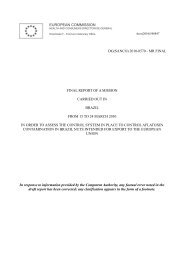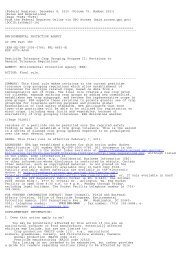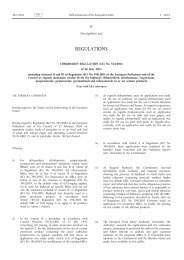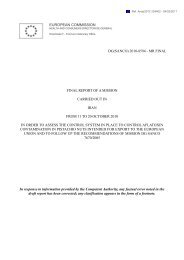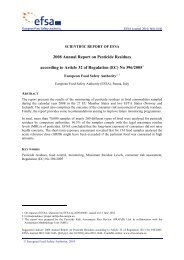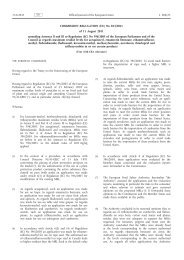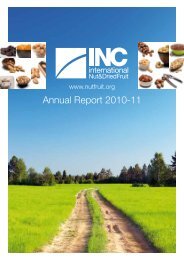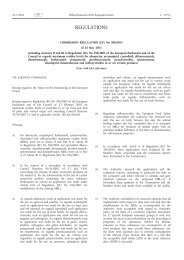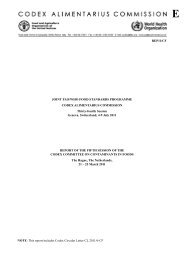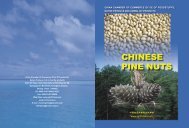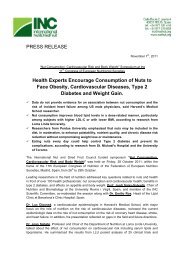Download - International Nut and Dried Fruit Council
Download - International Nut and Dried Fruit Council
Download - International Nut and Dried Fruit Council
Create successful ePaper yourself
Turn your PDF publications into a flip-book with our unique Google optimized e-Paper software.
Federal Register / Vol. 76, No. 56 / Wednesday, March 23, 2011 / Rules <strong>and</strong> Regulations16301erowe on DSK5CLS3C1PROD with RULESthe Congress <strong>and</strong> to the ComptrollerGeneral of the United States. EPA willsubmit a report containing this rule <strong>and</strong>other required information to the U.S.Senate, the U.S. House ofRepresentatives, <strong>and</strong> the ComptrollerGeneral of the United States prior topublication of this final rule in theFederal Register. This final rule is nota ‘‘major rule’’ as defined by 5 U.S.C.804(2).List of Subjects in 40 CFR Part 180Environmental protection,Administrative practice <strong>and</strong> procedure,Agricultural commodities, Pesticides<strong>and</strong> pests, Reporting <strong>and</strong> recordkeepingrequirements.Dated: March 11, 2011.Keith A. Matthews,Director, Biopesticides <strong>and</strong> PollutionPrevention Division, Office of PesticidePrograms.Therefore, 40 CFR chapter I isamended as follows:PART 180—[AMENDED]■ 1. The authority citation for part 180continues to read as follows:Authority: 21 U.S.C. 321(q), 346a <strong>and</strong> 371.■ 2. Section 180.1206, paragraph (c) isrevised to read as follows:§ 180.1206 Aspergillus flavus AF36;exemption from the requirement of atolerance.* * * * *(c) An exemption from therequirement of a tolerance is establishedfor residues of Aspergillus flavus AF36in or on corn, field, forage; corn, field,grain; corn, field, stover; corn, field,aspirated grain fractions; corn, sweet,kernel plus cob with husk removed;corn, sweet, forage; corn, sweet, stover;corn, pop, grain; <strong>and</strong> corn, pop, stover,when applied/used as an antifungalagent.[FR Doc. 2011–6545 Filed 3–22–11; 8:45 am]BILLING CODE 6560–50–PENVIRONMENTAL PROTECTIONAGENCY40 CFR Part 180[EPA–HQ–OPP–2007–0099; FRL–8863–8]Flubendiamide; Pesticide TolerancesAGENCY: Environmental ProtectionAgency (EPA).ACTION: Final rule.SUMMARY: This regulation establishes,modifies <strong>and</strong>/or revokes tolerances forresidues of flubendiamide N 2 -[1,1-dimethyl-2-(methylsulfonyl)ethyl]-3-iodo-N 1 -[2-methyl-4-[1,2,2,2-tetrafluoro-1-(trifluoromethyl)ethyl]phenyl]-1,2-benzenedicarboxamide, in or onmultiple food <strong>and</strong> livestockcommodities which are identified, <strong>and</strong>will be discussed in detail later in thisdocument. Bayer CropScience LP inc/o Nichino America, Inc. (U.S.subsidiary of Nihon Nohyaku Co., Ltd.)requested these tolerances, <strong>and</strong>revisions to tolerances under theFederal Food, Drug <strong>and</strong> Cosmetic Act(FFDCA).DATES: This regulation is effectiveMarch 23, 2011. Objections <strong>and</strong> requestsfor hearings must be received on orbefore May 23, 2011, <strong>and</strong> must be filedin accordance with the instructionsprovided in 40 CFR part 178 (see alsoUnit I.C. of the SUPPLEMENTARYINFORMATION).ADDRESSES: EPA has established adocket for this action under docketidentification (ID) number EPA–HQ–OPP–2007–0099. All documents in thedocket are listed in the docket indexavailable at http://www.regulations.gov.Although listed in the index, someinformation is not publicly available,e.g., Confidential Business Information(CBI) or other information whosedisclosure is restricted by statute.Certain other material, such ascopyrighted material, is not placed onthe Internet <strong>and</strong> will be publiclyavailable only in hard copy form.Publicly available docket materials areavailable in the electronic docket athttp://www.regulations.gov, or, if onlyavailable in hard copy, at the OPPRegulatory Public Docket in Rm. S–4400, One Potomac Yard (South Bldg.),2777 S. Crystal Dr., Arlington, VA. TheDocket Facility is open from 8:30 a.m.to 4 p.m., Monday through Friday,excluding legal holidays. The DocketFacility telephone number is (703) 305–5805.FOR FURTHER INFORMATION CONTACT:Carmen Rodia, Registration Division(7504P), Office of Pesticide Programs,Environmental Protection Agency, 1200Pennsylvania Avenue, NW.,Washington, DC 20460–0001; telephonenumber: (703) 306–0327; fax number:(703) 308–0029; e-mail address:rodia.carmen@epa.gov.SUPPLEMENTARY INFORMATION:I. General InformationA. Does this action apply to me?You may be potentially affected bythis action if you are an agriculturalproducer, food manufacturer, orpesticide manufacturer. Potentiallyaffected entities may include, but areVerDate Mar2010 15:27 Mar 22, 2011 Jkt 223001 PO 00000 Frm 00071 Fmt 4700 Sfmt 4700 E:\FR\FM\23MRR1.SGM 23MRR1not limited to those engaged in thefollowing activities:• Crop production (NAICS code 111).• Animal production (NAICS code112).• Food manufacturing (NAICS code311).• Pesticide manufacturing (NAICScode 32532).This listing is not intended to beexhaustive, but rather to provide a guidefor readers regarding entities likely to beaffected by this action. Other types ofentities not listed in this unit could alsobe affected. The North AmericanIndustrial Classification System(NAICS) codes have been provided toassist you <strong>and</strong> others in determiningwhether this action might apply tocertain entities. If you have anyquestions regarding the applicability ofthis action to a particular entity, consultthe person listed under FOR FURTHERINFORMATION CONTACT.B. How can I get electronic access toother related information?You may access a frequently updatedelectronic version of EPA’s toleranceregulations at 40 CFR part 180 throughthe Government Printing Office’s e-CFRsite at http://www.gpoaccess.gov/ecfr.C. How can I file an objection or hearingrequest?Under section 408(g) of FFDCA, 21U.S.C. 346a, any person may file anobjection to any aspect of this regulation<strong>and</strong> may also request a hearing on thoseobjections. You must file your objectionor request a hearing on this regulationin accordance with the instructionsprovided in 40 CFR part 178. To ensureproper receipt by EPA, you mustidentify docket ID number EPA–HQ–OPP–2007–0099 in the subject line onthe first page of your submission. Allobjections <strong>and</strong> requests for a hearingmust be in writing, <strong>and</strong> must bereceived by the Hearing Clerk on orbefore May 23, 2011. Addresses for mail<strong>and</strong> h<strong>and</strong> delivery of objections <strong>and</strong>hearing requests are provided in 40 CFR178.25(b).In addition to filing an objection orhearing request with the Hearing Clerkas described in 40 CFR part 178, pleasesubmit a copy of the filing that does notcontain any CBI for inclusion in thepublic docket. Information not markedconfidential pursuant to 40 CFR part 2may be disclosed publicly by EPAwithout prior notice. Submit a copy ofyour non-CBI objection or hearingrequest, identified by docket ID numberEPA–HQ–OPP–2007–0099, by one ofthe following methods:
16304 Federal Register / Vol. 76, No. 56 / Wednesday, March 23, 2011 / Rules <strong>and</strong> Regulationserowe on DSK5CLS3C1PROD with RULESare performed for a food-use pesticide,if a toxicological study has indicated thepossibility of an effect of concernoccurring as a result of a 1-day or singleexposure. Such effects were identifiedfor flubendiamide. In estimating acutedietary exposure, EPA used DEEM–FCID TM along with food consumptioninformation from the USDA 1994–1996<strong>and</strong> 1998 CSFII. As to residue levels infood, for the acute assessment, themodeled exposure estimates are basedon tolerance level residues, assuming100% of crops were treated. In addition,experimental processing (whereavailable) factors were assumed for bothregistered <strong>and</strong> requested crop uses.ii. Chronic exposure. In conductingthe chronic dietary exposure assessmentEPA used DEEM–FCID TM along with thefood consumption data from the USDA1994–1996 <strong>and</strong> 1998 CSFII. As toresidue levels in food, EPA assumed asubset of the currently registered cropscontain residues at the average residuelevels found in the crop field trials. Forthe newly proposed crops, livestockcommodities, <strong>and</strong> the remainingcurrently registered crops, EPA assumedtolerance level residues. In addition,experimental processing factors wereused where available. Finally, EPAassumed 100% of crops were treated.iii. Cancer. Based on the datasummarized in Unit III.A., EPA hasconcluded that flubendiamide should beclassified as ‘‘Not Likely To BeCarcinogenic to Humans.’’ As a result, acancer dietary exposure assessment forthe purpose of assessing cancer risk isunnecessary for flubendiamide, <strong>and</strong> wasnot conducted.iv. Anticipated residue information.Section 408(b)(2)(E) of FFDCAauthorizes EPA to use available data <strong>and</strong>information on the anticipated residuelevels of pesticide residues in food <strong>and</strong>the actual levels of pesticide residuesthat have been measured in food. If EPArelies on such information, EPA mustrequire pursuant to FFDCA section408(f)(1) that data be provided 5 yearsafter the tolerance is established,modified, or left in effect, demonstratingthat the levels in food are not above thelevels anticipated. For the presentaction, EPA will issue such data call-insas are required by FFDCA section408(b)(2)(E) <strong>and</strong> authorized underFFDCA section 408(f)(1). Data will berequired to be submitted no later than5 years from the date of issuance ofthese tolerances.2. Dietary exposure from drinkingwater. The Agency used Tier IIscreening level water exposure modelsin the dietary exposure analysis <strong>and</strong> riskassessment for flubendiamide indrinking water. These simulationmodels take into account data on thephysical, chemical <strong>and</strong> fate/transportcharacteristics of flubendiamide.Further information regarding EPAdrinking water models used in pesticideexposure assessment can be found athttp://www.epa.gov/oppefed1/models/water/index.htm.Flubendiamide is persistent <strong>and</strong>potentially mobile in terrestrial <strong>and</strong>aquatic environments. These fateproperties suggest that it has a potentialto move into surface water <strong>and</strong> groundwater. The Agency has completed adrinking water assessment forflubendiamide using screening levelwater exposure models that were basedon the existing <strong>and</strong> proposed uses. Forthe 1-in-10-year peak, the highest Tier 2Pesticide Root Zone Model/ExposureAnalysis Modeling System (PRZM/EXAMS) Estimated Drinking WaterConcentrations (EDWC) forflubendiamide was 24.57 parts perbillion (ppb), based on application tocorn. For the 1-in-10-year annualaverage, the highest PRZM/EXAMSEDWC was 11.46 ppb, also based onapplication to corn.A summary of the dietary exposurefrom drinking water for flubendiamideused for human risk assessment can befound in the documents entitled,‘‘Flubendiamide: Human Health RiskAssessment for Proposed Uses onAlfalfa, Globe Artichokes, the LowGrowing Berry Subgroup 13–07G(except Cranberry), Peanuts, Pistachios,the Small <strong>Fruit</strong> Vine Climbing (exceptFuzzy Kiwifruit) Subgroup 13–07F,Safflower, Sorghum, Sugarcane,Sunflower, <strong>and</strong> Turnip Greens, <strong>and</strong> anIncreased Application Rate for Brassica(Cole) Leafy Vegetables,’’ datedNovember 30, 2010, by going to http://www.regulations.gov. The referenceddocument is available in the docketestablished by this action, which isdescribed under ADDRESSES. Locate <strong>and</strong>click on the hyperlink for docket IDnumber EPA–HQ–OPP–2007–0099.Double-click on the document to viewthe referenced information onpage 27 of 62.3. From non-dietary exposure. Theterm ‘‘residential exposure’’ is used inthis document to refer to nonoccupational,non-dietary exposure(e.g., for lawn <strong>and</strong> garden pest control,indoor pest control, termiticides, <strong>and</strong>flea <strong>and</strong> tick control on pets).Flubendiamide is not registered for anyspecific use patterns that would resultin residential exposure.4. Cumulative effects from substanceswith a common mechanism of toxicity.Section 408(b)(2)(D)(v) of FFDCArequires that, when considering whetherto establish, modify, or revoke aVerDate Mar2010 15:27 Mar 22, 2011 Jkt 223001 PO 00000 Frm 00074 Fmt 4700 Sfmt 4700 E:\FR\FM\23MRR1.SGM 23MRR1tolerance, the Agency consider‘‘available information’’ concerning thecumulative effects of a particularpesticide’s residues <strong>and</strong> ‘‘othersubstances that have a commonmechanism of toxicity.’’EPA has not found flubendiamide toshare a common mechanism of toxicitywith any other substances, <strong>and</strong>flubendiamide does not appear toproduce a toxic metabolite produced byother substances. For the purposes ofthis tolerance action, therefore, EPA hasassumed that flubendiamide does nothave a common mechanism of toxicitywith other substances. For informationregarding EPA’s efforts to determinewhich chemicals have a commonmechanism of toxicity <strong>and</strong> to evaluatethe cumulative effects of suchchemicals, see EPA’s Web site athttp://www.epa.gov/pesticides/cumulative.D. Safety Factor for Infants <strong>and</strong>Children1. In general. Section 408(b)(2)(C) ofFFDCA provides that EPA shall applyan additional tenfold (10x) margin ofsafety for infants <strong>and</strong> children in thecase of threshold effects to account forprenatal <strong>and</strong> postnatal toxicity <strong>and</strong> thecompleteness of the database on toxicity<strong>and</strong> exposure unless EPA determinesbased on reliable data that a differentmargin of safety will be safe for infants<strong>and</strong> children. This additional margin ofsafety is commonly referred to as theFQPA SF. In applying this provision,EPA either retains the default value of10x, or uses a different additional safetyfactor when reliable data available toEPA support the choice of a differentfactor.2. Prenatal <strong>and</strong> postnatal sensitivity.While both the rat <strong>and</strong> rabbitdevelopmental studies did not identifyteratogenic effects <strong>and</strong> showed noevidence of increased pre-natalsusceptibility, adverse eye effects (eyeenlargement) were noted in post-natalrat pups older than 14 days in multiplestudies (the 2-generation reproduction<strong>and</strong> 1-generation supplemental studies).Additionally, the DNT study reportedeye effects appearing in some offspringbetween lactation days 14 <strong>and</strong> 42, eventhough exposure stopped at lactationday 21, indicating a possible delay(a latent response) from the time of lastexposure to onset of bupthalmos. Theseeye effects did not occur in adult rats.Since the iris <strong>and</strong> chamber angle aredifferentiating <strong>and</strong> specializing intodefinite structures during post-nataldays 5 to 20, neonatal rats appear tohave an increased susceptibility toflubendiamide exposure as compared toadults.
16306 Federal Register / Vol. 76, No. 56 / Wednesday, March 23, 2011 / Rules <strong>and</strong> Regulationserowe on DSK5CLS3C1PROD with RULESThe Codex Alimentarius is a joint U.N.Food <strong>and</strong> Agriculture Organization/World Health Organization foodst<strong>and</strong>ards program, <strong>and</strong> it is recognizedas an international food safetyst<strong>and</strong>ards-setting organization in tradeagreements to which the United Statesis a party. EPA may establish a tolerancethat is different from a Codex MRL;however, section 408(b)(4) of FFDCArequires that EPA explain the reasonsfor departing from the Codex level.There are currently no MRLs establishedby Codex, Canada, or Mexico forflubendiamide.C. Revisions To Petitioned-ForTolerancesThe Agency’s Guidance for SettingPesticide Tolerances Based on FieldTrial Data was utilized for determiningappropriate tolerance levels for manyraw agricultural commodities (RACs)which showed quantifiable residues inor on samples that were treatedaccording to the proposed use patterns.The following revisions to tolerancelevels were made:Based upon review of the datasupporting PP 0F7685, recalculated beef<strong>and</strong> dairy cattle, swine, <strong>and</strong> poultrydietary burdens, <strong>and</strong> re-evaluation ofpreviously submitted animal feedingstudies, EPA has determined that theestablished tolerances for residues offlubendiamide for milk fat, <strong>and</strong> the meat<strong>and</strong> fat of cattle, goat, horse <strong>and</strong> sheepshould be increased to 1.0 ppm, 0.08ppm <strong>and</strong> 0.70 ppm, respectively. Forswine (hog), EPA has determined thatthe proposed tolerances for hog, fat at0.15 ppm; hog, kidney at 0.06 ppm; hog,liver at 0.06 ppm; <strong>and</strong> hog, muscle at0.02 ppm should be established aspermanent tolerances for residues offlubendiamide in or on hog, fat at 0.15ppm, <strong>and</strong> the proposed tolerances forhog, kidney; hog, liver; <strong>and</strong> hog, muscleshould be increased <strong>and</strong> established aspermanent tolerances for residues offlubendiamide in or on hog, meat <strong>and</strong>hog, meat byproducts; at 0.15 ppm <strong>and</strong>0.03 ppm, respectively. For poultry,EPA has determined that the establishedtolerances for eggs, fat, liver <strong>and</strong> meatshould be increased to 0.40 ppm, 3.0ppm, 0.60 ppm <strong>and</strong> 0.10 ppm,respectively.As part of this regulation, permanenttolerances for residues of flubendiamidein or on alfalfa, forage (25 ppm) <strong>and</strong>alfalfa, hay (65 ppm) resulting fromdirect application to the primary cropare being established. These tolerancessupersede the currently listed tolerancesfor indirect or inadvertent residues offlubendiamide in or on alfalfa, forage(0.15 ppm) <strong>and</strong> alfalfa, hay (0.04 ppm),<strong>and</strong>; therefore, the indirect/inadvertentresidue tolerances are being revokedfrom 40 CFR 180.639(d).V. ConclusionTherefore, new tolerances are beingestablished for residues offlubendiamide [N 2 -[1,1-dimethyl-2-(methylsulfonyl)ethyl]-3-iodo-N 1 -[2-methyl-4-[1,2,2,2-tetrafluoro-1-(trifluoromethyl)ethyl]phenyl]-1,2-benzenedicarboxamide], in or onartichoke, globe at 1.6 parts per million(ppm); berry, low growing, subgroup13–07G, except cranberry at 1.5 ppm;fruit, small vine climbing except fuzzykiwifruit, subgroup 13–07F at 1.4 ppm;hog, fat at 0.15 ppm; hog, meatbyproducts at 0.15 ppm; hog, meat at0.03 ppm; peanut, hay at 60 ppm;peanut, meal at 0.03 ppm; peanut,nutmeat at 0.02 ppm; peanut, refined oilat 0.03 ppm; pistachio at 0.06 ppm;safflower, seed at 5.0 ppm; sorghum,grain, forage at 12 ppm; sorghum, grain,grain at 5.0 ppm; sorghum, grain, stoverat 14 ppm; sugarcane, cane at 0.30 ppm;sunflower, seed at 5.0 ppm; <strong>and</strong> turnip,greens at 25 ppm.The established tolerances forresidues of flubendiamide for milk fat,<strong>and</strong> the meat <strong>and</strong> fat of cattle, goat,horse <strong>and</strong> sheep are being increased to1.0 ppm, 0.08 ppm <strong>and</strong> 0.70 ppm,respectively. For poultry, theestablished tolerances for eggs, fat, liver<strong>and</strong> meat are being increased to 0.40ppm, 3.0 ppm, 0.60 ppm <strong>and</strong> 0.10 ppm,respectively.The established tolerances forresidues of flubendiamide for brassica,head <strong>and</strong> stem, subgroup 5A; brassica,leafy greens, subgroup 5B; <strong>and</strong> grain,aspirated grain fractions are beingincreased to 3.0 ppm, 25 ppm, <strong>and</strong> 153ppm, respectively.The established tolerances for indirector inadvertent residues offlubendiamide in or on alfalfa, forage(0.15 ppm) <strong>and</strong> alfalfa, hay (0.04 ppm)are being revoked from 40 CFR180.639(d), <strong>and</strong> established aspermanent tolerances, in 40 CFR180.639(a)(2), for residues offlubendiamide in or on alfalfa, forage at25 ppm; <strong>and</strong> alfalfa, hay at 65 ppm.VI. Statutory <strong>and</strong> Executive OrderReviewsThis final rule establishes tolerancesunder section 408(d) of FFDCA inresponse to a petition submitted to theAgency. The Office of Management <strong>and</strong>Budget (OMB) has exempted these typesof actions from review under ExecutiveOrder 12866, entitled RegulatoryPlanning <strong>and</strong> Review (58 FR 51735,October 4, 1993). Because this final rulehas been exempted from review underExecutive Order 12866, this final rule isVerDate Mar2010 15:27 Mar 22, 2011 Jkt 223001 PO 00000 Frm 00076 Fmt 4700 Sfmt 4700 E:\FR\FM\23MRR1.SGM 23MRR1not subject to Executive Order 13211,entitled Actions Concerning RegulationsThat Significantly Affect Energy Supply,Distribution, or Use (66 FR 28355, May22, 2001) or Executive Order 13045,entitled Protection of Children fromEnvironmental Health Risks <strong>and</strong> SafetyRisks (62 FR 19885, April 23, 1997).This final rule does not contain anyinformation collections subject to OMBapproval under the PaperworkReduction Act (PRA), 44 U.S.C. 3501 etseq., nor does it require any specialconsiderations under Executive Order12898, entitled Federal Actions toAddress Environmental Justice inMinority Populations <strong>and</strong> Low-IncomePopulations (59 FR 7629, February 16,1994).Since tolerances <strong>and</strong> exemptions thatare established on the basis of a petitionunder section 408(d) of FFDCA, such asthe tolerance in this final rule, do notrequire the issuance of a proposed rule,the requirements of the RegulatoryFlexibility Act (RFA) (5 U.S.C. 601 etseq.) do not apply.This final rule directly regulatesgrowers, food processors, food h<strong>and</strong>lers,<strong>and</strong> food retailers, not States or tribes,nor does this action alter therelationships or distribution of power<strong>and</strong> responsibilities established byCongress in the preemption provisionsof section 408(n)(4) of FFDCA. As such,the Agency has determined that thisaction will not have a substantial directeffect on States or tribal governments,on the relationship between the nationalgovernment <strong>and</strong> the States or tribalgovernments, or on the distribution ofpower <strong>and</strong> responsibilities among thevarious levels of government or betweenthe Federal Government <strong>and</strong> Indiantribes. Thus, the Agency has determinedthat Executive Order 13132, entitledFederalism (64 FR 43255, August 10,1999) <strong>and</strong> Executive Order 13175,entitled Consultation <strong>and</strong> Coordinationwith Indian Tribal Governments (65 FR67249, November 9, 2000) do not applyto this final rule. In addition, this finalrule does not impose any enforceableduty or contain any unfunded m<strong>and</strong>ateas described under Title II of theUnfunded M<strong>and</strong>ates Reform Act of 1995(UMRA) (Pub. L. 104–4).This action does not involve anytechnical st<strong>and</strong>ards that would requireAgency consideration of voluntaryconsensus st<strong>and</strong>ards pursuant to section12(d) of the National TechnologyTransfer <strong>and</strong> Advancement Act of 1995(NTTAA), Public Law 104–113, section12(d) (15 U.S.C. 272 note).VII. Congressional Review ActThe Congressional Review Act, 5U.S.C. 801 et seq., generally provides
Federal Register / Vol. 76, No. 56 / Wednesday, March 23, 2011 / Rules <strong>and</strong> Regulations16307erowe on DSK5CLS3C1PROD with RULESthat before a rule may take effect, theagency promulgating the rule mustsubmit a rule report to each House ofthe Congress <strong>and</strong> to the ComptrollerGeneral of the United States. EPA willsubmit a report containing this rule <strong>and</strong>other required information to the U.S.Senate, the U.S. House ofRepresentatives, <strong>and</strong> the ComptrollerGeneral of the United States prior topublication of this final rule in theFederal Register. This final rule is nota ‘‘major rule’’ as defined by 5 U.S.C.804(2).List of Subjects in 40 CFR Part 180Environmental protection,Administrative practice <strong>and</strong> procedure,Agricultural commodities, Pesticides<strong>and</strong> pests, Reporting <strong>and</strong> recordkeepingrequirements.Dated: March 15, 2011.Lois Rossi,Director, Registration Division, Office ofPesticide Programs.Therefore, 40 CFR chapter I isamended as follows:PART 180—[AMENDED]■ 1. The authority citation for part 180continues to read as follows:Authority: 21 U.S.C. 321(q), 346a <strong>and</strong> 371.■ 2. Section 180.639 is revised to readas follows:§ 180.639 Flubendiamide; tolerances forresidues.(a) General. (1) Tolerances areestablished for residues of theinsecticide flubendiamide per se N 2 -[1,1-Dimethyl-2-(methylsulfonyl)ethyl]-3-iodo-N 1 -[2-methyl-4-[1,2,2,2-tetrafluoro-1-(trifluoromethyl)ethyl]phenyl]-1,2-benzenedicarboxamide, in or on thefollowing commodities:CommodityParts permillionAlmond, hulls ............................ 9.0Apple, wet pomace ................... 2.0Corn, field, forage ..................... 8.0Corn, field, grain ....................... 0.03Corn, field, stover ..................... 15Corn, pop, grain ........................ 0.02Corn, pop, stover ...................... 15Corn, sweet, forage .................. 9.0Corn, sweet, kernel plus cobwith husks removed .............. 0.01Corn, sweet, stover .................. 25Cotton gin byproducts .............. 60Cotton, undelinted seed ........... 0.90<strong>Fruit</strong>, pome, group 11 ............... 0.70<strong>Fruit</strong>, stone, group 12 ............... 1.6Grape ........................................ 1.4<strong>Nut</strong>, tree, group 14 ................... 0.06Okra .......................................... 0.30Vegetable, cucurbit, group 9 .... 0.20CommodityParts permillionVegetable, fruiting, group 8 ...... 0.60Vegetable, leafy, except Brassica,group 4 ......................... 11(2) Tolerances are established forresidues of flubendiamide, including itsmetabolites <strong>and</strong> degradates, in or on thecommodities in the table below.Compliance with the tolerance levelsspecified in the table is to bedetermined by measuring onlyflubendiamide N 2 -[1,1-dimethyl-2-(methylsulfonyl)ethyl]-3-iodo-N 1 -[2-methyl-4-[1,2,2,2-tetrafluoro-1-(trifluoromethyl)ethyl]phenyl]-1,2-benzenedicarboxamide, in or on thefollowing commodities:CommodityParts permillionAlfalfa, forage ........................... 25Alfalfa, hay ................................ 65Artichoke, globe ........................ 1.6Berry, low growing, subgroup13–07G, except cranberry .... 1.5Brassica, head <strong>and</strong> stem, subgroup5A ............................... 3.0Brassica, leafy greens, subgroup5B ............................... 25Cattle, fat .................................. 0.70Cattle, meat .............................. 0.60Cattle, meat byproducts ........... 0.08Egg ........................................... 0.40<strong>Fruit</strong>, small fruit vine climbingexcept fuzzy kiwifruit, subgroup13–07F ........................ 1.4Goat, fat .................................... 0.70Goat, meat ................................ 0.60Goat, meat byproducts ............. 0.08Grain, aspirated grain fractions 153Hog, fat ..................................... 0.15Hog, meat ................................. 0.15Hog, meat byproducts .............. 0.03Horse, fat .................................. 0.70Horse, meat .............................. 0.60Horse, meat byproducts ........... 0.08Milk ........................................... 0.15Milk, fat ..................................... 1.0Pea <strong>and</strong> bean, dried shelled,except soybean, subgroup6C .......................................... 0.60Pea <strong>and</strong> bean, succulentshelled, subgroup 6B ............ 0.05Peanut, hay .............................. 60Peanut, meal ............................ 0.03Peanut, nutmeat ....................... 0.02Peanut, refined oil .................... 0.03Pistachio ................................... 0.06Poultry, fat ................................ 3.0Poultry, liver .............................. 0.60Poultry, meat ............................ 0.10Rice, grain 1 .............................. 0.50Safflower, seed ......................... 5.0Sheep, fat ................................. 0.70Sheep, meat ............................. 0.60Sheep, meat byproducts .......... 0.08Sorghum, grain, forage ............. 12Sorghum, grain, grain ............... 5.0Sorghum, grain, stover ............. 14Soybean, forage ....................... 18Soybean, hay ............................ 60CommodityParts permillionSoybean, hulls .......................... 0.80Soybean, seed .......................... 0.25Sugarcane, cane ...................... 0.30Sunflower, seed ........................ 5.0Turnip, greens .......................... 25Vegetable, foliage of legume,except soybean, subgroup7A .......................................... 35Vegetable, legume, edible podded,subgroup 6A ................. 0.501There are no U.S. registrations for rice,grain.(b) Section 18 emergency exemptions.[Reserved](c) Tolerances with regionalregistrations. [Reserved](d) Indirect or inadvertent residues.Tolerances are established for residuesof the insecticide flubendiamide per seN 2 -[1,1-Dimethyl-2-(methylsulfonyl)ethyl]-3-iodo-N 1 -[2-methyl-4-[1,2,2,2-tetrafluoro-1-(trifluoromethyl)ethyl]phenyl]-1,2-benzenedicarboxamide, in or on thefollowing raw agricultural commoditieswhen present therein as a result of theapplication of flubendiamide to thegrowing crops listed in paragraph (a)(1)of this section:CommodityParts permillionBarley, hay ................................ 0.04Barley, straw ............................. 0.07Buckwheat ................................ 0.07Clover, forage ........................... 0.15Clover, hay ............................... 0.04Grass, forage ............................ 0.15Grass, hay ................................ 0.04Millet, pearl, forage ................... 0.15Millet, pearl, hay ....................... 0.04Millet, proso, forage .................. 0.15Millet, proso, hay ...................... 0.04Millet, proso, straw ................... 0.07Oats, forage .............................. 0.15Oats, hay .................................. 0.04Oats, straw ............................... 0.07Rye, forage ............................... 0.15Rye, straw ................................. 0.07Teosinte, forage ........................ 0.15Teosinte, hay ............................ 0.04Teosinte, straw ......................... 0.07Triticale, forage ......................... 0.15Triticale, hay ............................. 0.04Triticale, straw .......................... 0.07Wheat, forage ........................... 0.15Wheat, hay ............................... 0.03Wheat, straw ............................. 0.03[FR Doc. 2011–6888 Filed 3–22–11; 8:45 am]BILLING CODE 6560–50–PVerDate Mar2010 15:27 Mar 22, 2011 Jkt 223001 PO 00000 Frm 00077 Fmt 4700 Sfmt 9990 E:\FR\FM\23MRR1.SGM 23MRR1



